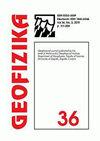基于普通克里格法和人工智能方法的地下水电导率空间分析(以伊朗大不里士平原为例)
IF 1.1
4区 地球科学
Q4 GEOCHEMISTRY & GEOPHYSICS
引用次数: 13
摘要
近几十年来,人工智能(AI)系统为分析水工程和环境问题开辟了新的视野。本文研究了普通克里格(OK)作为线性地统计估计量的性能,以及人工神经网络(ANN)和自适应神经模糊推理系统(ANFIS)两种智能方法。为此,将位于伊朗西北部大不里士平原的120口观测井的地理坐标定义为模型的输入,将地下水电导率(EC)设置为模型的输出。80%的数据是随机选择的,用于训练和开发上述模型,20%的数据用于测试和验证。最后,将模型的输出与观测井的相应实测值进行了比较。结果表明,ANFIS模型精度最高,RMSE值为1.69 dS。m,相关系数(R) 0.84。ANN和OK的RMSE值分别为1.97和2.14 dS。m和R值分别为0.79和0.76。结果表明,ANFIS方法能较准确地预测EC,可用于模拟地下水盐度。本文章由计算机程序翻译,如有差异,请以英文原文为准。
Spatial analysis of groundwater electrical conductivity using ordinary kriging and artificial intelligence methods (Case study: Tabriz plain, Iran)
Artificial intelligence (AI) systems have opened a new horizon to analyze water engineering and environmental problems in recent decades. In this study performances of ordinary kriging (OK) as a linear geostatistical estimator and two intelligent methods including artificial neural networks (ANN) and adaptive neuro-fuzzy inference system (ANFIS) are investigated. For this purpose, geographical coordinates of 120 observation wells that located in Tabriz plain, north-west of Iran, were defined as inputs and groundwater electrical conductivities (EC) were set as output of models. Eighty percent of data were randomly selected to train and develop mentioned models and twenty percent of data used for testing and validating. Finally, the outputs of models were compared with the corresponding measured values in observation wells. Results indicated that ANFIS model provided the best accuracy among models with the root mean squared error (RMSE) value of 1.69 dS.m and correlation coefficient (R) of 0.84. The RMSE values in ANN and OK were calculated 1.97 and 2.14 dS.m and the R values were determined 0.79 and 0.76, respectively. According to the results, the ANFIS method predicted EC precisely and can be advised for modeling groundwater salinity.
求助全文
通过发布文献求助,成功后即可免费获取论文全文。
去求助
来源期刊

Geofizika
地学-地球化学与地球物理
CiteScore
1.60
自引率
0.00%
发文量
17
审稿时长
>12 weeks
期刊介绍:
The Geofizika journal succeeds the Papers series (Radovi), which has been published since 1923 at the Geophysical Institute in Zagreb (current the Department of Geophysics, Faculty of Science, University of Zagreb).
Geofizika publishes contributions dealing with physics of the atmosphere, the sea and the Earth''s interior.
 求助内容:
求助内容: 应助结果提醒方式:
应助结果提醒方式:


